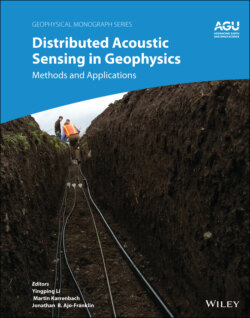Читать книгу Distributed Acoustic Sensing in Geophysics - Группа авторов - Страница 41
2.3. INTERROGATOR UNIT 2.3.1. Types of Interrogators
ОглавлениеThe laser that emits light pulses and the hardware measuring system to convert the backscattered light to a strain measurement are housed in the interrogator unit (IU). The dotted black line in Figure 2.2, left, shows a conceptual diagram of an IU. A pulse of light is emitted from the laser into a fiber‐optic cable inside the IU. The light then encounters several optical elements inside the IU and exits using a surface cable connected to the length of fiber being used as a strain detector (e.g., in a well or shallow trench near the surface of the earth). The backscattered laser light returns from the sensing fiber and reenters the IU, where the light is routed through more optical devices, eventually encountering a receiver that converts the light into analog electrical signals that are then converted to a digital data stream using digitizers, typically in a supporting computer system.
IUs might use several different optical designs to emit laser light into the optical fiber that converts the backscattered signals into a measurement of strain (Hartog, 2017). Practically all current hardware on the market use a differential phase method to obtain a high‐fidelity and linear measurement of strain. Note that earlier technology, based only on the amplitude of the backscattered signal, did not provide a reliable measurement of strain, because the amplitude of the backscattered light was not linear with strain.
Essential to the reliable measurement of strain is the concept of a dual‐pulse optical system. This methodology creates two pulses of backscattered light combined in an interferometric process to construct the phase difference between these pulses. These two pulses of light are delayed in time from each other, either at the launch path of the IU or by a time‐delay loop of fiber in the receiver path of the IU. This time delay corresponds to what is called the “gauge length,” the corresponding length of fiber it takes to create (half of) this time delay. Independent of the design, the effect of this time delay is to allow the system to compare the phase of the backscattered light at all points of the sensing fiber, each separated by gauge length. Figure 2.2 shows an example where the gauge is a physical loop of fiber creating a time delay of the backscattered light at the receiver path of the IU.
Figure 2.2 shows that the IU outputs are two signals—I and Q. The I signal is the interference of the direct optical path and the long optical path through the gauge, and the Q signal is created from the quadrature of the I signal. The phase of the vector spanned by the I and Q signals provides the differential phase measurement related to the strain in the fiber. Figure 2.2, right, shows how the phase is computed from the I and Q signals using:
(2.1)
The arctangent function returns a value within the phase range of –π/2 to +π/2. To obtain a continuous function of phase as a function of time, the computed phase values must be unwrapped by adding or subtracting integer multiples of π to the time series (Tribolet, 1977). The relative strain ε(z, t) at each point z on the fiber at time t can be computed from this phase difference by (Equation 10, SEAFOM, 2018):
(2.2)
where λ is the wavelength of the laser light in vacuum used by the DAS interrogator, n is the refractive index of the glass, γ is the photoelastic scaling factor (γ ≈ 0.78) for axial strain on silica fiber (Giallorenzi et al., 1982), and G is the gauge length. Strain rate can be computed from Equation 2.2 by taking the time derivative.
